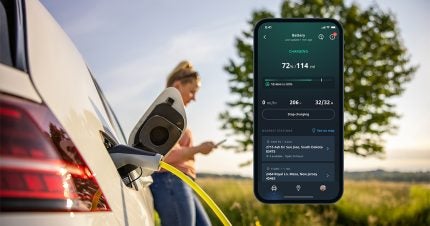
One major obstacle to EV adoption is ‘EV charging anxiety’; it’s a feeling referring to uncertainties or negativity around accessing and/or using an EV charge point. Those uncertainties and issues are in stark contrast to the ease of the refuelling process and culture that comes with incumbent ICE tech.
Making the switch from an ICE vehicle to an EV is already a major technological change for many. There are new elements of driving to manage and fit into lifestyles – such as charging costs, using a charger, where to find charging points. This amounts to what can be termed EV charging anxiety.
We spoke to Drew Meehan, EV expert at TomTom – a UK mapping/location specialist – to learn more about charging issues and what can be done to ease the associated stress points.

Just Auto (JA): What is charging anxiety?
Drew Meehan (DM): EV charging anxiety refers to the concern or stress that electric vehicle (EV) owners may experience regarding the availability, accessibility, or speed of charging infrastructure for their vehicles.

US Tariffs are shifting - will you react or anticipate?
Don’t let policy changes catch you off guard. Stay proactive with real-time data and expert analysis.
By GlobalDataIt encompasses worries about finding available charging stations, the time it takes to charge the vehicle, the distance between charging points, and the fear of running out of battery power before reaching a charging station.
What are some of the causes of this concern?
Charging anxiety these days isn’t about finding a charger, it’s whether and how it works when you get there. The infrastructure is very uneven around the world, and even in countries where it’s good, data about charger status is still inconsistent and often hard to trust. There is still a lack of uniformity among charging networks.
Charging anxiety these days isn’t about finding a charger, it’s whether and how it works when you get there.
Different plug types, payment methods, and charging speeds make the whole experience confusing for EV users. Drivers are spending lots of time at chargers that don’t work; they become stressed trying to figure them out. What should be a simple task – plugging in and charging – turns into a complicated experience due to these differences and uncertainties.
On top of handling multiple subscriptions and apps, EV drivers often face unreliable information about charging points. Apps might show available chargers, but upon arrival, they could be broken or occupied. Sometimes, the app might promise fast chargers that aren’t actually there, leading to longer-than-expected waits for charging.
As an EV driver, it’s a lot to manage – understanding charging costs, speeds, and where to find available charging points. These complexities are new for most drivers and add layers of challenges to the EV charging experience.
How can location data help combat charging anxiety?
Location tech companies have an important role to play in tackling charging anxiety. In TomTom’s case, it starts with using data effectively and showing its value in the move towards electrification.
On the charging challenge, we’re trying to educate and work with charge point operators, the companies that install them, to show them the value good data creates. And we want to show them what we need to give drivers great EV driving experiences. We’re helping carmakers develop systems that give drivers more reliable and useful data on all things related to charging. But we’re also building more collaborative and reciprocal relationships with them.
Let’s say we spot a problem with their data. We want to get that rectified, but we also want to be able to share that and provide feedback to improve that data, permanently, for everyone.
On the charging challenge, we’re trying to educate and work with charge point operators, the companies that install them, to show them the value good data creates.
We’re also taking the world of EV charging data, validating it and consolidating it into one unified source. We have many sources of data with lots of different information; sometimes they overlap, sometimes one source has data that another source lacks. If we were to rely on one source, we’d often lack crucial information about chargers, their state and so on. We’ve developed automated rules that bring all this data together. Combining all this gives us a fuller picture of reality and gives the driver the richest, maximum amount of utility.
One of TomTom’s strengths is fantastic data around traffic and maps, points of interest and EV charging stations. TomTom is also working directly with partners to build solutions that take, for example, background data on where chargers are and charging prices at different stations.
Adding this real-time integrated car data as a layer of data to a map, takes that map from being a tool to help someone get from A to B, to being a device that drivers can trust and keeps them relaxed, on schedule and in control of their trip.
It doesn’t have to all be in-dash; this information can also be accessed from your phone. So, you can take a look before you leave and say, ‘Oh, this isn’t going to be too bad. I’m going to stop one time, it’s here and it’s going to cost me about this much.’ And then you can get into your car, knowing that you have that peace of mind.
What else can be done by OEMs, local authorities and others?
To reduce EV charging anxiety, we believe a collaborative effort among OEMs, local councils, and governments is crucial. First, there is a need for expanding the charging infrastructure by strategically placing more public charging stations in urban centres, along motorways, workplaces, and residential areas. That is vital. Standardising charging connectors and protocols also ensures compatibility among different EV models, simplifying the charging process.
Additionally, tax credits, subsidies, and other forms of financial assistance can encourage people and companies to invest in public infrastructure projects like home charging stations. Working with local authorities to accelerate the permitting processes for the installation of charging stations can also improve the efficiency of this process.
Furthermore, EV drivers are empowered to plan routes more effectively when real-time information about charging station availability is made readily available through mobile apps and navigation systems.
What do you think the future holds for this issue?
As the world goes electric, we must find ways to make living with EVs and using them as simple and effortless as possible. We need to rethink the experience and create something new, something that solves the problems of anyone or any business that uses electric vehicles. We need to create an excellent EV experience. OEMs can take advantage of enormous opportunities when they have access to quality data, interactions, and in-car communications. They make getting into an electric vehicle (EV) simpler and provide an improved experience compared to getting into an internal combustion engine (ICE) vehicle.
At the moment, it’s all about solving base-level problems, like not being able to find chargers or trust that they’ll work when you get there. Right now, we need a lot of apps to do these things and the car does relatively little when it should probably do more. It’s not very human-friendly.
The industry still has a way to go before charging anxiety is completely eliminated, but a brighter, more electrified future is possible if we can create a more straightforward, unified charging infrastructure and give drivers better tools and data to manage the charging experience.
The next logical step is to make all this more convenient for people and in a way that maximizes efficiency, naturally. We know that going electric will change the way people use cars, but what we also see is that we can evolve systems and tech to the point where drivers won’t ever need to think about charging at all. It should become such a natural thing to just plug in wherever you are.
The industry still has a way to go before charging anxiety is completely eliminated, but a brighter, more electrified future is possible if we can create a more straightforward, unified charging infrastructure and give drivers better tools and data to manage the charging experience.



